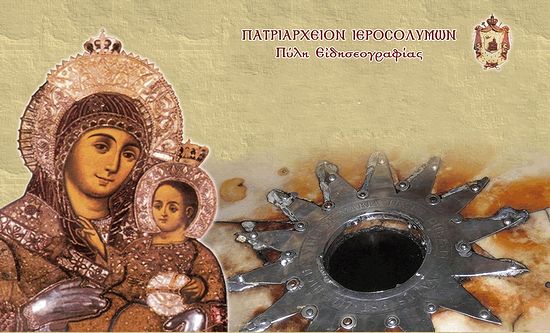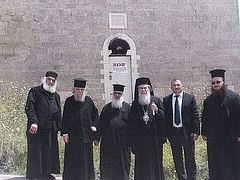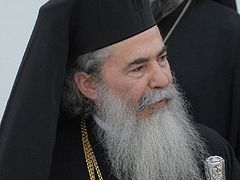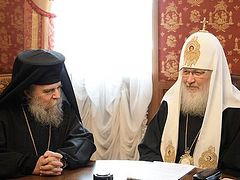Source: Jerusalem Patriarchate
October 16, 2015
Given the state of world affairs, it’s hard to imagine that one of the oldest and most successful examples of a religious institution thriving peacefully amid political turmoil lies in the heart of the world’s most notorious conflict, especially when that institution is part and parcel to the very land in question.
The Patriarchate of Jerusalem is the oldest continuous and only local religious institution in the Holy Land. Autocephalous (self-governing) in administration, it does not orient itself toward an outside authority in the way that the Catholic presence in Jerusalem refers to the Vatican, for example. The Orthodox Church’s Patriarch, who as a bishop is the direct successor of the Apostle James, is recognized by the local governmental authorities of its jurisdiction, and represents all Christians of the Holy Land. Even the ecclesiastical courts are recognized by both Jordanian and Israeli law.
Finding Equilibrium in the Political Realm
The approach of the Church of Jerusalem to remain an apolitical entity, an idea which is rooted in theology but applied at every practical level, has contributed to its own long-lasting survival and growth in the Holy Land throughout ages of invasion, war, and entry into modernity. Herein lie some important lessons for the various religions, governments and social spheres that constitute the region. One of the biggest questions facing all of them is to what extent and how exactly religion fits at once with politics into the Holy Land, which by definition invites both a religious and political atmosphere.
What makes the case of the Patriarchate such an intriguing one for any person or entity seeking to strike the right balance between religion and politics, free speech and respect of beliefs, is that it is based in a city that is primarily important because of its significance to religious groups yet politically crucial to most of the world. If the delicate dance between religion and politics can work here, in this diverse, tense place where religion is the raison d’être, it can work anywhere.
After the State of Israel, the Patriarchate is the nation’s largest landholder, even owning the land upon which the Knesset building stands today. Many local Palestinian Christians speak or are familiar with the Greek language, which is a remnant of Palestine’s Byzantine past, and almost every clergyman speaks Arabic.
While, over time, other groups came to stake their claims on the Holy Land, the influence of the Greek Orthodox (or more accurately, the Rum Orthodox, referring to the Christianized and Hellenized Roman Empire), did not diminish. Even amid destruction and loss of life, including the Persian invasion, centuries of Arab-Muslim rule, and the brutal Crusader period, among others, the Church endured and maintained a high status by the governing authorities of the time.
For example, the acknowledgment of the Patriarchate’s authority through its classification as a “millet” (a separate legal court for a confessional community) by the Ottomans, allowed it to continue to actually own all its public properties, maintaining the Patriarch as the titleholder and administrator of all lands registered in his name as well as under the name of the Orthodox community. This explains the Patriarchate’s control of the Orthodox communities’ public properties in Israel and the Occupied Palestinian Territories and also its ability to register lands as waqf to this day. The Status Quo law, implemented during Ottoman times is still followed, continuing to guarantee the rightful authority of the Greek Orthodox Church over most of the Christian holy places, as well as protecting other rights involving property ownership and its legal status.
Historical Ties with Muslim-Majority Nations
Until today, the Patriarchate actually gives legitimacy to the historical claims that the Hashemite Kingdom of Jordan and the Palestinian Authority have over the Muslim holy places – claims which stem from the Covenant of Omar. This covenant was the agreement made between Patriarch Sophronios and Caliph Omar ibn al Khattab during the Muslim invasion of Jerusalem in 637 AD. Their agreement has been the foundation upon which legal agreements between the Patriarchate and the governments of its jurisdictional authority have been made since.
The legal jurisdiction of the Patriarchate of Jerusalem includes lands today that are within the borders of Israel, the Palestinian Authority, the Hashemite Kingdom of Jordan, and the Gulf State of Qatar; all majority Muslim regions. While bordering countries are also Muslim majority and are unequivocally experiencing Christian and other minority persecution, the Patriarchate enjoys a great respect from the local and regional civil authorities, and indeed maintains a very special relationship with the Islamic world, including Arab, Ottoman and other Muslim cultures.
Although Qatar and the Arabian Gulf share a history with Christianity (histories of local saints and ancient Christian mosaics are until today being uncovered in their desert regions) it wasn’t until 1997 that Archimandrite Theophilos (now Patriarch Theophilos III of Jerusalem) had traveled to Qatar in order to fulfill the pastoral needs of the country’s Christian expatriates. Due to his diplomatic relations with the former emir Sheikh Hamad ibn Al Thani, and the help of the former American ambassador to Qatar, an agreement was made for a plot of land upon which the construction of a church building was permitted. Saint Isaac and Saint George’s Church is the first modern-day Church in Qatar, and one of the only in the entire Gulf region. According to Archbishop Makarios, who has been leading the Christian flock in Qatar for two decades, it is an example of how to be united as Christians and have symbiosis between Christians and Muslims in that part of the world. He performs Divine Liturgy in Arabic, Greek, Serbian, Russian and English for a cultural mosaic of believers.
As a result of the pastoral concern of the Patriarchate of Jerusalem and its respectful, ever-strengthening relationship with the authorities of Qatar, five other Christian denominations were also given the approval to build houses of worship. The area of Abu Hamour, where the designated land for church buildings is located, has transformed from an empty stretch of desert into a bustling, well-known area of Doha that serves as a beacon of tolerance and respect, and has helped catapult Qatar into a league of its own in the Islamic world.
These are a few examples of success stories for the Church in terms of religion finding its equilibrium with the political realm and with other religions, including religions that do not make a distinction between religious and civil law. Interestingly, while the Church maintains a role that is purely spiritual in its mission, it is precisely the significance of the millennia-old spiritual establishment that makes it a political heavyweight in Jerusalem.
Fearing the “Other” Is Regressive and Fruitless
An examination of the Patriarchate of Jerusalem could also provide some important answers for societies who fear the “other,” proving that banning of religious symbols in France, outlawing minarets in Switzerland, executing Muslims who convert to Christianity in Saudi Arabia and other Islamic nations, are all regressive and fruitless approaches.
According to the Patriarch Theophilos of Jerusalem, there are two reasons why the Patriarchate has thrived here through the ages. The first, and theological answer, he says, is based on the words of Jesus Christ, “And I tell you, you are Peter, and upon this rock I shall build my Church, and the powers of death shall not prevail against it,” (Matt. 16:18).
The second, according to his own experience as a member of the monastic order of the Patriarchate of Jerusalem, the Brotherhood of the Holy Sepulcher, is the fact that the Patriarchate has never deviated from its purely spiritual mission of guarding the holy places as places of active worship, open to all people regardless of race or creed. In one of the Holy Land’s most powerful examples, Jews, Muslims and people from various other religions and ethnic backgrounds can be found at any given time visiting the Church of Holy Sepulcher.
This example can be applied to the world’s comparable disputes about common space: there is room for everyone. It is the sanctity of the holy places over which Orthodox Christians have claims because it is their sanctity that gives them value. More important than asserting physical claims of exclusivity is knowledge of one’s own identity, and consequently one’s own values. Upon achieving this, keeping out “the other” is a waste of time.
In a world so often at war over territory, the Patriarchate of Jerusalem offers an enlightened view. For example, one persistent subject of concern regarding the conflict here is the political status of Jerusalem. Jerusalem is a city that’s most important attribute is being a place of sacredness to millions of people who align with one of the Abrahamic faiths. By definition that means that one particular piece of land often carries significant meaning for more than one religion. It is for this reason that the Church values people’s claims to the sacredness of the holy places, as opposed to exclusive land claims. According to the Church, the holiness of a particular place is not at all dependent upon our presence there, so anyone should be allowed to share in its sanctity.
But not every individual in a diverse city like Jerusalem respects the sacred sites of other religions, or their respective followers. The Patriarchate has experienced numerous and increasing incidents of violence against their Brotherhood or vandalism of holy shrines.
Its official position points again to the words of Jesus Christ, expressed by Saint John the Evangelist, that God is love, and “anyone who hates his brother is a murderer, and anyone who is a murderer has no eternal life abiding in him,” (1 John 3:15). In terms of taking legal or punitive action against perpetrators, the Church leaves the full responsibility to police and other public safety officials.
Cultural Evolution of Humankind Founded on Theocracy
In a time when blasphemous content can spark acts of vengeance, such as the violent January 2015 incident in Paris where writers at the Charlie Hebdomagazine were shot in retaliation for an offensive expression of the prophet Muhammad, the Church offers a powerful example from a religious institution. It recognizes its spiritual role exclusively, consciously declines political involvement of any kind (not including humanitarian aid), and condemns all forms of violence. This is what helped the institution and the Christian presence in the Holy Land maintain itself through the ages. Today this approach is largely responsible for the Patriarchate’s remarkable good relations with all the governing authorities of its jurisdiction, which have historically been at war with each other.
While separating religion and politics is at the heart of the Patriarchate’s mission, one particular piece of advice from Patriarch Theophilos is that no metaphoric wall should be erected when separating “church” (i.e. religion) and state. He urges all leaders of nations not to disregard the role of religion in any national context or framework because of the fact that religion has determined, shaped and formed cultural identity over the course of human history. While the idea of separating church and state seems a very logical one, and has been a successful standard for most modern-day democracies, implementing such separation is not a “black or white” process.
In the words of Patriarch Theophilos, it is important to understand that the cultural evolution and development of mankind has its fountain in theocracy. The breakthrough person – the one who actually challenged this theocratic history and human inclination – is Jesus Christ, who famously said to those who provoked him on the subject, render unto Caesar what is due to Caesar, and to God what is due unto God. That idea is what the Patriarchate of Jerusalem credits itself as doing. Without rejecting or renouncing religion, keeping at the forefront of our collective consciousness the idea of respecting the other seems to be the key to thriving in a place like the Holy Land and in conflict. Patriarch Theophilos admits that every real stumbling block of peaceful coexistence and reconciliation in the region has been religious fundamentalism.
Education Combats Fundamentalism and Develops Respect
One of the most effective ways to combat fundamentalist ideology and to manifest mutual respect is through education. The Patriarchal schools, which are the oldest schools in the Holy Land and were the only schools in the Ottoman Empire, are extremely valuable in surviving and even surmounting the challenges facing the region. Their number-one objective is to provide young people with knowledge of their identity. More than 8,500 Muslim and Christian students are enrolled, and 800 employed (with a special emphasis on providing dignified employment for women in traditional society) in the 18 schools throughout the Patriarchate’s jurisdiction. Classes focus on general education, not including religion, due to the fact that the majority of students are Muslim. Currently, the Patriarchal schools rank second and third place among all schools in Jordan. The hope is that through comprehensive education, a generation of well-informed, critically thinking, confident individuals who have learned to grow together, will be prepared for the world that awaits them.
While globalized society, especially in the Middle East, continues to face dilemmas that are being articulated in the form of a choice between secular or religious rule, it’s important to remember that there need not be a choice at all. In one of the most conflicted and diverse regions of the world, a shining example of how to maneuver between religion and politics, seems to lie in the Patriarchate of Jerusalem. As a longtime survivor of conflict and promoter of peace, its lesson is to make respect for the other a priority and keep the focus on one’s own mission.
* * *
This article is published in the Palestine-Israel Journal October 2015 issue entitled “Religion and the Conflict.”





Bravo to the writer!!!